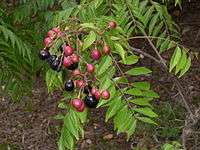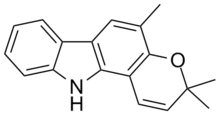Curry tree
The curry tree (Murraya koenigii) is a tropical to sub-tropical tree in the family Rutaceae (the rue family, which includes rue, citrus, and satinwood), and is native to Asia.[2]
| Curry tree | |
|---|---|
 | |
| Scientific classification | |
| Kingdom: | Plantae |
| Clade: | Tracheophytes |
| Clade: | Angiosperms |
| Clade: | Eudicots |
| Clade: | Rosids |
| Order: | Sapindales |
| Family: | Rutaceae |
| Genus: | Murraya |
| Species: | M. koenigii |
| Binomial name | |
| Murraya koenigii | |
Its leaves are used in many dishes in the Indian subcontinent. Often used in curries, the leaves are generally called by the name "curry leaves", although they are also actually "sweet neem leaves" in most Indian languages.
Etymology and common names
The species' generic name, Murraya koenigii, derives from Johann Andreas Murray (1740-1791), who studied botany under Carl Linnaeus and became a professor of medicine with an interest in herbalism at the University of Göttingen, Germany.[2]
Curry tree is also called curry leaf tree or curry bush, among numerous local names, depending on country.[3][4]
Description

It is a small tree, growing 4–6 m (13–20 feet) tall, with a trunk up to 40 cm (16 in) diameter. The aromatic leaves are pinnate, with 11–21 leaflets, each leaflet 2–4 cm (0.79–1.57 in) long and 1–2 cm (0.39–0.79 in) broad. The plant produces small white flowers which can self-pollinate to produce small shiny-black drupes containing a single, large viable seed. The berry pulp is edible, with a sweet flavor.[4]
Distribution and habitat
The tree is native to the Indian subcontinent.[5] Commercial plantations have been established in India, and more recently Australia.[5]
It grows best in well-drained soils in areas with full sun or partial shade, preferably away from the wind. Growth is more robust when temperatures are at least 18°C (65°F).[6]
Uses

The fresh leaves are valued as seasoning in the cuisines of South and Southeast Asia.[4] They are most widely used in southern and west coast Indian cooking, usually fried along with vegetable oil, mustard seeds and chopped onions in the first stage of the preparation. They are also used to make thoran, vada, rasam and kadhi. In Cambodia, the leaves are roasted and used as an ingredient in a soup, maju krueng.[6] In Java, the leaves are often stewed to flavor gulai. Though available dried, the aroma and flavor is greatly inferior.[5] The oil can be extracted and used to make scented soaps.[6]
The leaves of Murraya koenigii are also used as a herb in Ayurvedic and Siddha medicine in which they are believed to possess anti-disease properties,[6][4][6] but there is no high-quality clinical evidence for such effects.
Propagation
Seeds must be ripe and fresh to plant; dried or shriveled fruits are not viable. One can plant the whole fruit, but it is best to remove the pulp before planting in potting mix that is kept moist but not wet. Stem cuttings can be also used for propagation.[2]
Chemical constituents
Compounds found in curry tree leaves, stems, bark, and seeds include cinnamaldehyde,[7] and numerous carbazole alkaloids, including mahanimbine,[8] girinimbine,[9] and mahanine.
References
- "Murraya koenigii". Germplasm Resources Information Network (GRIN). Agricultural Research Service (ARS), United States Department of Agriculture (USDA).
- "Murraya koenigii". Missouri Botanical Garden, St. Louis, MO, USA. 2019. Retrieved 13 August 2019.
- "Murraya koenigii (curry leaf tree)". CABI. 14 July 2018. Retrieved 13 August 2019.
- "Murraya koenigii (L.) Spreng". From: Parmar, C. and M.K. Kaushal. 1982. Murraya koenigii. p. 45–48. In: Wild Fruits. Kalyani Publishers, New Delhi, India. In: NewCROP, New Crop Resource Online Program, Center for New Crops and Plant Products, Purdue University. 1982. Retrieved 14 August 2019.
- Norman, Jill (2002). Herbs & Spices: The Cook's Reference. New York, New York: DK Publishing. pp. 212, 213. ISBN 0789489392.
- "Curry leaf tree (Murraya koenigii)". Heritage Garden. Retrieved 2019-04-02.
- Sankar Ganesh, Ravishankar Rai; et al. (2015). "In vitro antibiofilm activity of Murraya koenigii essential oil extracted using supercritical fluid CO2 method against Pseudomonas aeruginosa PAO1". Natural Product Research. 29 (24): 2295–2298. doi:10.1080/14786419.2015.1004673. ISSN 1478-6427. PMID 25635569.
- "Mahanimbine". PubChem. 2017.
- "Girinimbine". PubChem. 2017.
